Bulletin – March 2010 Household Consumption Trends in China
- Download the article 128KB
Abstract
Despite strong growth in Chinese consumption, the household consumption ratio has fallen significantly. This reflects a fall in the share of national income that accrues to the household sector and a rise in the household saving ratio. Policies to encourage the growth of small and medium-sized entities, increase social spending, and reduce the focus on investment-led growth would be expected to support the level of household consumption over the medium term.
Introduction
Compared with other countries, household consumption expenditure in China has grown at a strong pace for an extended period. Nonetheless, the share of household consumption in total expenditure in the Chinese economy has declined, as the growth in investment spending and exports has been even more rapid than that of consumption, especially in the 2000s decade. This article outlines these trends and the factors that have driven them, focusing on the decreasing share of total national income that accrues to the household sector and the increase in the household saving ratio. It also discusses recent government initiatives that are intended to boost consumption spending over the short and medium term.
Recent Trends in Household Consumption
Household consumption has grown rapidly in China over the past two decades, averaging around 8 per cent a year and rising to around 10 per cent in the past few years.[1] This is well above the pace recorded in most other countries, with China's real annual household consumption growth on average 3 percentage points higher than other emerging economies in Asia and 6 percentage points higher than in the G7 advanced countries (Graph 1).
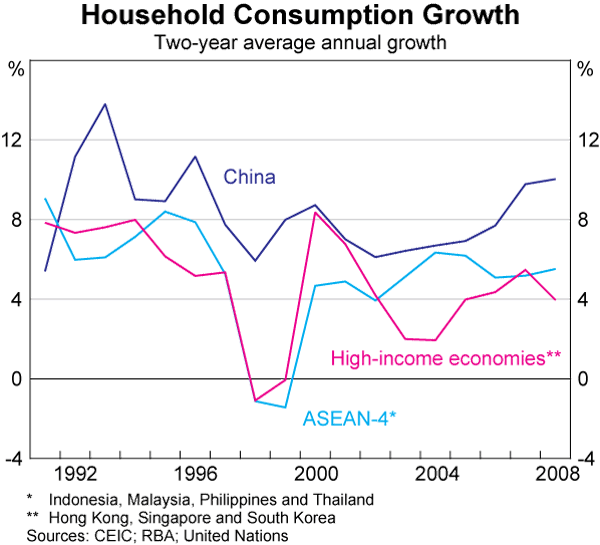
Despite this strong growth, the share of household consumption in China's total expenditure has declined. For many years this trend was fairly gradual, with the household consumption ratio falling from 52 per cent of GDP in the early 1980s to 46 per cent of GDP by the end of the 1990s. However, the pace of the decline picked up noticeably in the 2000s, with the household consumption ratio falling a further 11 percentage points, to be 35 per cent of GDP in 2008. In contrast, consumption ratios in other emerging Asian economies have typically remained around 55–60 per cent of GDP over recent decades (Graph 2).
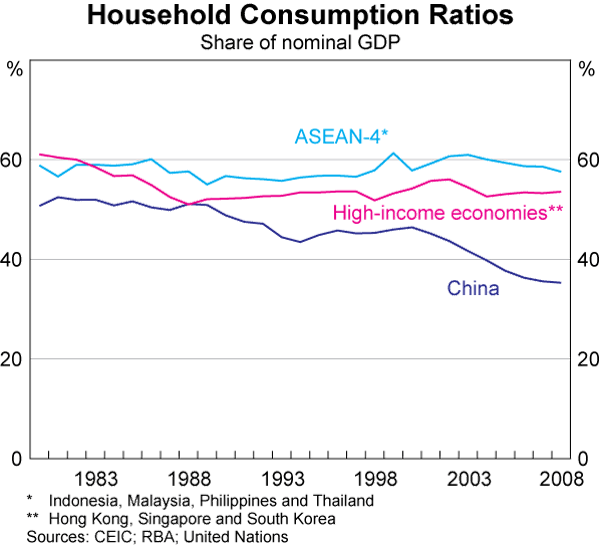
The fall in the consumption share in China has been accompanied by a large increase in the shares of investment and trade in GDP (Graph 3). Although household consumption has continued to grow at a solid pace, investment spending has grown even more rapidly and the contribution to growth from net exports has also increased significantly. This divergence between the pace of real growth of consumption and that of all other spending has led to a reduction in the household consumption ratio by around 1 percentage point of GDP a year in the 2000s; slower growth of consumption prices relative to GDP prices reduced the ratio by an additional ½ percentage point a year during this period.
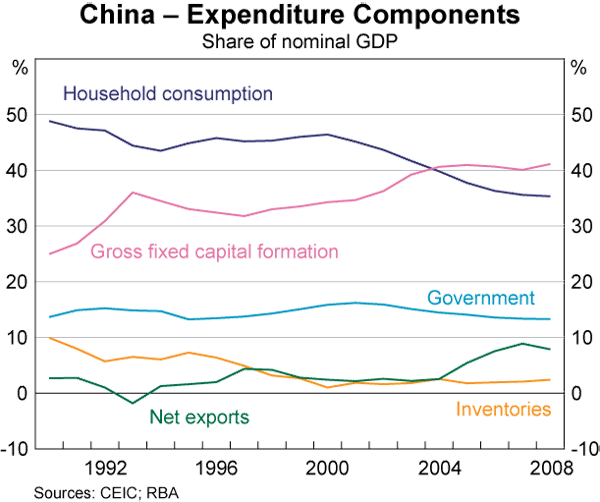
Changes in the Household Income Share and the Saving Ratio
Two broad factors account for the large fall in the share of household consumption in total expenditure during the 2000s: first, a decline in the share of national income that accrues to the household sector, and second a large rise in the household saving ratio.
According to recently published flow of funds data, which cover the period 1992 to 2007, the share of household disposable income in GDP has declined significantly, falling from around 66 per cent in the late 1990s to 57 per cent recently (Graph 4).[2] At the same time, the shares of total national income accruing to the corporate and especially the government sectors have risen. The increase in the corporate income share mainly reflects developments in their non-production activities – lower costs following the termination in the late 1990s of the requirement that enterprises provide social services to their workers, higher dividend income from their investments abroad, and lower net interest payments – while the increase in the government income share is due to higher tax receipts.
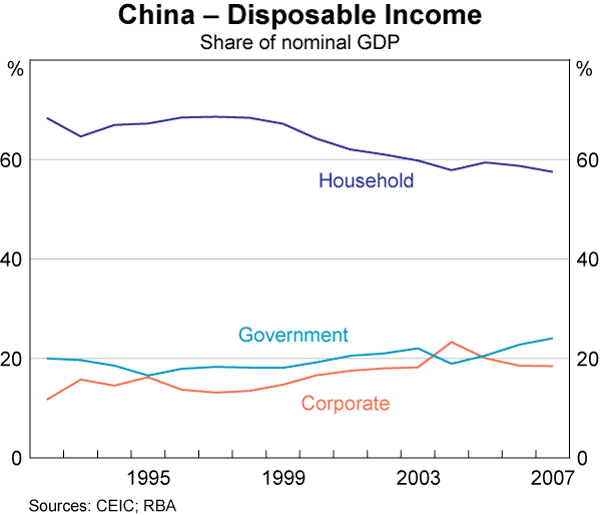
The fall in the share of household disposable income in GDP reflects comparatively weak growth in non-wage labour earnings and higher tax and interest payments. On the inflows side, almost 90 per cent of household income in China is derived from labour earnings, around half of which is wages and salaries from the formal sector and the other half is derived from farm production and other unincorporated activities. Wages and salaries from the formal sector remained fairly constant at around 30 per cent of GDP throughout the 1990s and 2000s, as strong growth in real wages offset modest growth in formal sector employment due to ongoing enterprise restructuring (Graph 5). In contrast, after rising during the 1990s, growth in income from farm production and unincorporated activities lagged the rapid pace of overall GDP by a wide margin, with its share in national income consequently falling by around 4 percentage points of GDP. Other inflows to the household sector – mainly pensions and other transfers received from the government and interest receipts – remained quite small and fairly steady as a share of GDP; dividend income paid to the household sector is negligible in China.
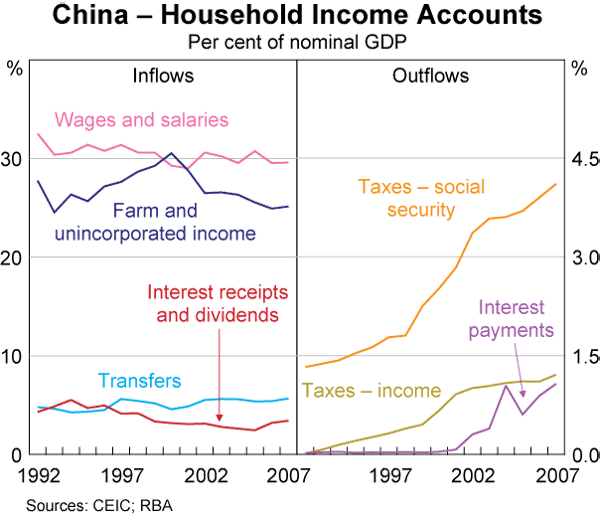
At the same time, outflows from household income increased markedly during the 2000s. Total taxes on labour income rose by 2½ percentage points of GDP, partly due to higher income tax payments but mostly reflecting mandatory contributions to a new pay-as-you-go (PAYG) pension system managed by the government sector that is being phased in across the country.[3] In addition, household interest payments increased from near zero to 1 per cent of GDP after the widespread devolution of home ownership to the household sector in 1998 and the associated increase in mortgage-related debt. As a consequence of these developments, the share of household disposable income (after tax and interest payments) in overall GDP fell sharply.
The second factor behind the comparatively slower pace of consumption growth has been the increase in household savings in the 2000s. After dipping in the late 1990s, the household saving ratio has increased steadily, rising from 27 per cent of disposable income at the start of the decade to reach a historic high of 38 per cent recently (Graph 6). This partly reflects demographic factors; China is at a peak in terms of the size of its working-age population share, which is projected to decline over the next decade. But it also reflects an increase in the desired stock of savings ahead of future spending on big-ticket items such as children's tertiary education, medical care, care of ageing parents and housing, especially in light of the termination in the late 1990s of the requirement that enterprises provide some of these services to their workers. The increase in the level of household savings needed to make these types of purchases can be considerable: with regard to home purchases alone, owner-occupiers are required to place a deposit equal to at least 20 per cent of the purchase price, although the average is much higher and many home buyers pay fully in cash.
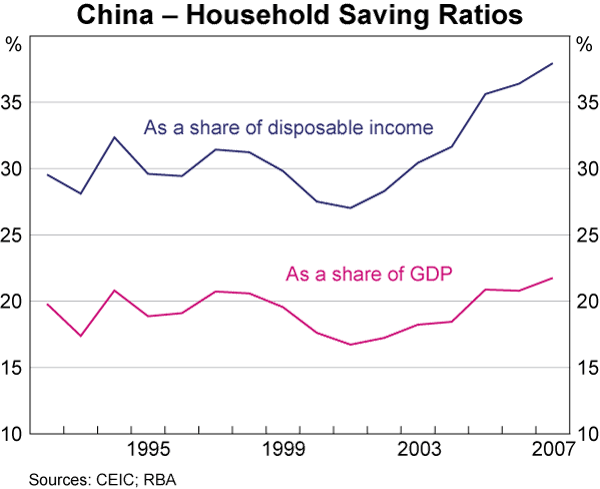
These changes in household income and behaviour in the past decade have had a marked effect on expenditure patterns in China. First, the devolution of home ownership resulted in a near doubling in the share of dwelling investment to GDP between the late 1990s and the early 2000s, effectively representing an increase in spending by the household sector on housing at the cost of lower spending on non-housing consumption during this period (Graph 7).[4] Second, the rise in the corporate income share in part funded the large increase in business investment, especially given the absence of any dividend transfer requirement by state-owned companies and of alternative attractive saving instruments. Third, much of the increase in tax collections by the government in the early 2000s was channelled into higher publicly funded investment. Finally, given the increase in productive capacity that resulted from the higher level of business investment, rapid growth in exports relative to imports increased the trade surplus as a share of GDP, especially after 2004. All of these factors contributed to the recent large decline in the consumption to GDP share in China.

Policies to Lift Household Consumption
Over recent years, the Chinese authorities have taken a number of steps to support household consumption. Some of these measures have a short-term focus, while others are more structural in nature and involve a gradual rebalancing of economic growth away from investment and exports and towards higher consumption.
With regard to short-term policies, the VAT on cars and a number of other items has been reduced, and vouchers for certain durable goods purchases by the rural sector have been provided, in the context of the current stimulus package. Several of these policies have recently been extended. Sales of these items have increased in the past year or so, although as was noted in the November 2009 Monetary Report of the People's Bank of China, part of this demand likely reflects a pull forward in the timing of such purchases.
With regard to medium-term policies, the government has taken a series of steps that are likely to moderate the high household saving ratio and support consumption growth over time. Government spending on health and education has increased from around 2¾ per cent of GDP in 2006 to around 3¾ per cent of GDP by 2008, while the full phase-in of the government PAYG pension system noted earlier will gradually lift the level of pension transfers to the household sector. The government also intends to phase in a national health system and rural-sector pensions and has introduced policies to enhance the portability of pension entitlements across provinces. The health care program includes plans to develop a universal basic health insurance system for urban residents, new rural cooperatives, and improvements in health care infrastructure and pharmaceutical provision. The rural pension will be paid to citizens aged over 60 years regardless of their contribution period, with the system phased in from end 2009. Credit availability to the household sector is also rising, reducing the need for saving in advance of big-ticket purchases and for precautionary saving by the household sector. These policies will, however, likely take some time to have a significant effect on the household saving ratio; the level of social spending still remains low by international standards and there are several intergovernmental issues to address to ensure the various new initiatives are fully financed over time.[5]
Several policies are also being implemented or discussed to boost the level of wage and non-wage income of the household sector. The government has introduced measures to stimulate the growth of small and medium-sized enterprises (SMEs), including guarantees on their borrowing, tax reductions and subsidies. SMEs are typically a large share of total employment in other countries and hence their expansion – especially in the retail and wholesale sectors, which are dominated by state-owned enterprises in China – could significantly boost both employment and household income over time. Other options to promote the growth of SMEs include the simplification of licensing arrangements and the development of risk-pricing and management practices in the banking sector to better assess SME loan applications. Greater competition and interest rate liberalisation within the financial sector could also raise interest rates on the sizeable pool of household deposits and thereby boost the low level of non-wage household income.
Finally, to help rebalance income and expenditure shares across the economy, several commentators have suggested that dividend distributions from state-owned enterprises be increased in order to finance higher government social spending and transfers and reduce the level of retained earnings in these enterprises.[6]
Conclusion
While household consumption has continued to grow solidly in China, its share in GDP has declined. This has been associated with a sharp fall in the share of disposable income accruing to the household sector and a rise in the household saving ratio. The authorities are putting in place policies to promote SMEs and increase social spending by the government, and are discussing other ways to reduce the focus on investment-led growth. While there are complex issues to address in each of these areas, they could over time have a substantive impact on household consumption in China.
Footnotes
Mark Baker is from the Asian Economies Research Unit and David Orsmond is from Economic Analysis Department. [*]
The Chinese statistical authorities publish estimates of nominal but not real household consumption. The estimates shown here are those of the United Nations, which are consistent with the authorities' estimates for the real growth of total consumption by the government and household sectors and budget data. Retail sales data also show strong growth for an extended period. [1]
For further discussion of these data and recent saving patterns, see Wiemer (2009) and the accompanying articles in that issue. [2]
Starting from the year 2000, the government has been gradually replacing enterprise-based pensions with a mandatory PAYG benefit, with employer contributions set at 20 per cent and employee at 8 per cent of nominal wages; see Dunaway and Arora (2007). [3]
Chinese consumption data do not include an implicit rent component to reflect the ongoing value of dwelling services. [4]
The intergovernmental reform in 1994 centralised revenue flows while leaving responsibility for much expenditure at the local level. Additional social expenditures were added as responsibilities of the local administrations in the late 1990s and only part of the new rural pension will be paid by the central government, with the share varying by province. For further details on these measures and a discussion of intergovernmental funding issues, see Qiao and Song (2009) and Dabla-Norris (2005). [5]
From 2008, all non-financial state-owned enterprises pay a dividend varying between 5 to 10 per cent of their profits to the State-Owned Assets Supervision and Administration Commission; these funds are held by SASAC to cover expected future enterprise restructuring costs, such as pension obligations. For a discussion, see ChinaStakes (2007) and Kuijs, Mako and Zhang (2005). [6]
References
ChinaStakes (2007), ‘Pay Dividends’, 13 December.
Dabla-Norris E (2005), ‘Issues in Intergovernmental Fiscal Relations in China’, IMF Working Paper No 05/30.
Dunaway S and V Arora (2007), ‘Pension Reform in China: The Need for a New Approach’, IMF Working Paper No 07/109.
Kuijs L, W Mako and C Zhang (2005), ‘SOE Dividends: How Much and to Whom?’, World Bank Policy Note, 17 October.
Qiao H and Y Song (2009), ‘China's Savings Rate and its Long-Term Outlook’, Goldman Sachs Global Economics Paper No 191.
Wiemer C (2009), ‘The Big Savers: Households and Government’, China Economic Quarterly, 13(4), pp 20–25.